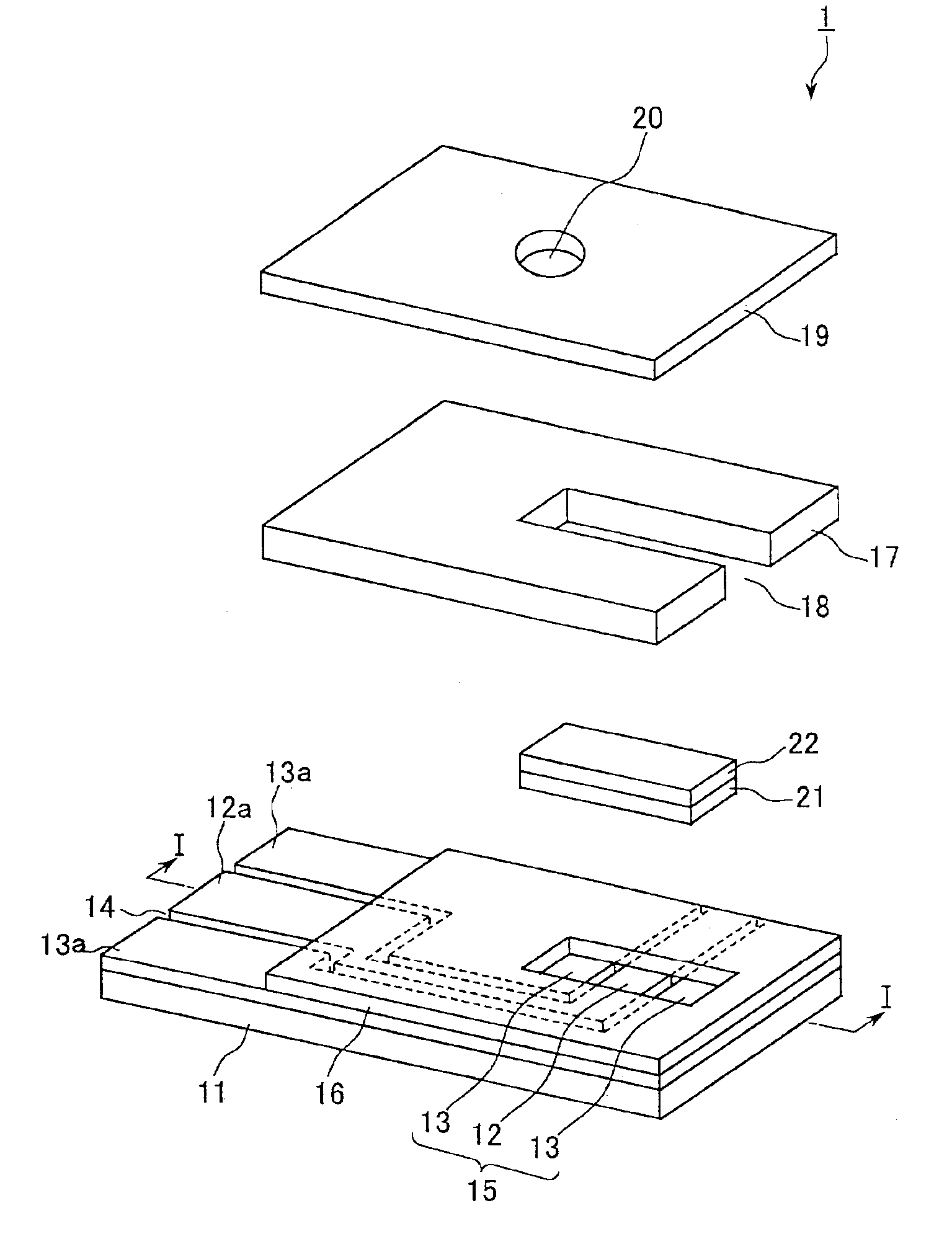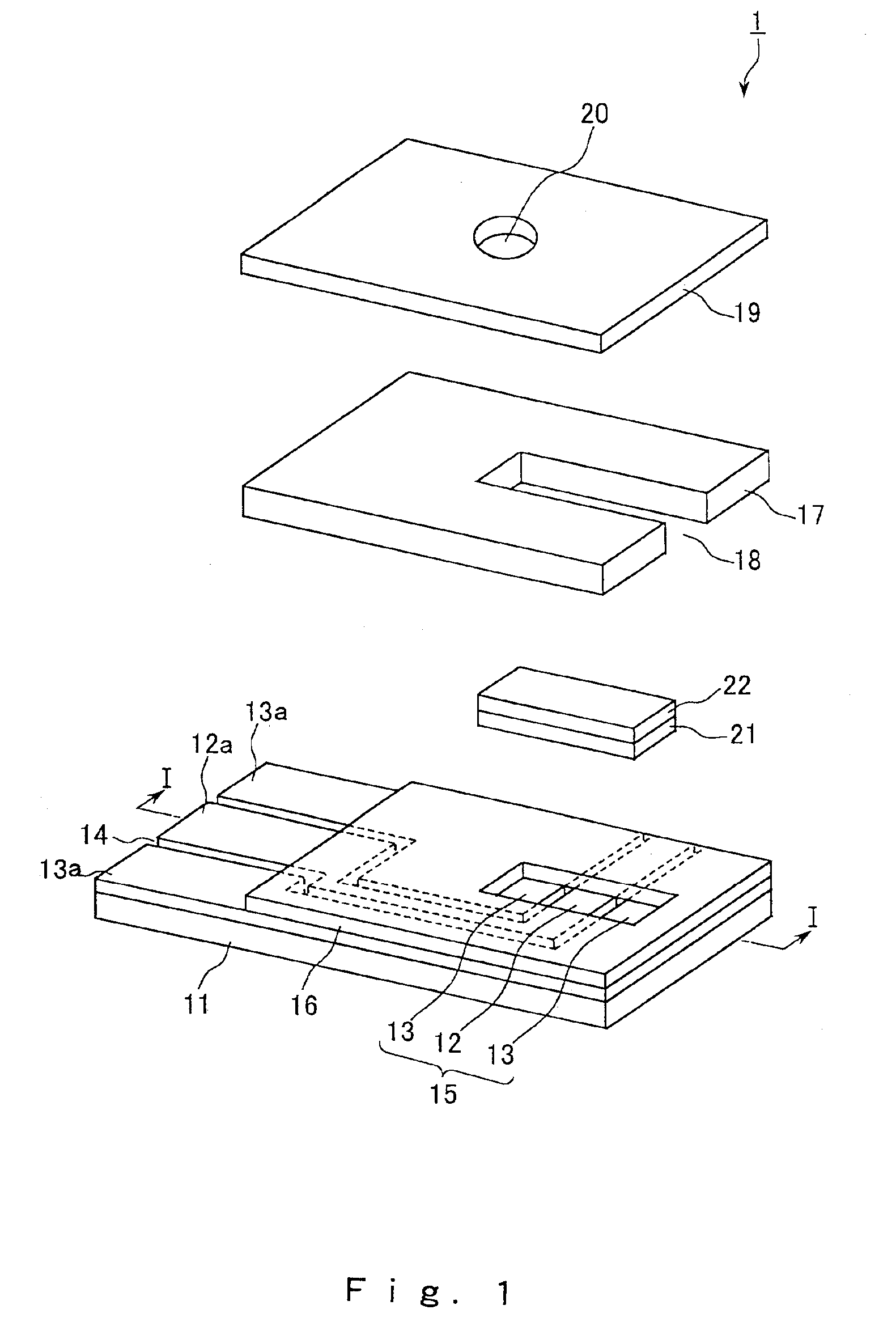Biosensor
a biosensor and sensor technology, applied in the field of biosensors, can solve the problems of unstable layer form, slow enzyme reaction, difficult to improve measurement precision,
- Summary
- Abstract
- Description
- Claims
- Application Information
AI Technical Summary
Benefits of technology
Problems solved by technology
Method used
Image
Examples
embodiment 1
(Embodiment 1)
[0044]FIGS. 1 and 2 show an example of a biosensor of the present invention. FIG. 1 is a perspective view schematically showing the biosensor, and FIG. 2 is a cross-sectional view taken along line I—I of FIG. 1.
[0045]As shown in the drawings, this biosensor 1 includes a substrate 11, an electrode system including a working electrode 12 having a lead portion 12a and two counter electrodes 13 having lead portions 13a, a particulate-containing layer 21, a reagent-containing layer 22, a spacer 17, and a cover 19. A detecting portion 15 is provided on one end portion (on the right side of FIGS. 1 and 2) of the substrate 11, and the two counter electrodes 13 and the working electrode 12 are alternately disposed parallel with the width direction of the substrate 11 on the detecting portion 15. The electrodes drawn out from the detecting portion 15 are disposed on the substrate 11 in such a manner that the electrodes are bent before reaching the lead portions 12a and 13a of th...
embodiment 2
(Embodiment 2)
[0087]This embodiment is an example of the biosensor of the present invention having a surfactant-containing layer on the reagent-containing layer. FIG. 3 is a cross-sectional view of this biosensor. In FIG. 3, the same components as those in FIG. 2 bear the same reference numeral.
[0088]As shown in FIG. 3, the biosensor 3 has the same structure as in Embodiment 1, except that a surfactant-containing layer 31 is laminated on the reagent-containing layer 22. Thus, if the surfactant-containing layer 31 is provided, not only can the sample and the reagents be mixed rapidly and uniformly, but also the sample liquid in the capillary structure can be drawn in more rapidly and more reliably.
[0089]The content of the surfactant in the surfactant-containing layer 31 can be determined as appropriate, depending on the type or the amount of the sample to be supplied, the type of the surfactant or the like.
[0090]The surfactant-containing layer 31 can be formed by, for example, prepar...
example 1
[0091]A biosensor for measuring glucose having the same structure as that shown in FIG. 3 was produced in the following manner.
[0092]First, a PET sheet (manufactured by Toray Industries. Inc.) was prepared as the substrate 11, and a carbon electrode system including a working electrode and counter electrodes, each of which had a lead portion, was formed on one surface thereof. The carbon electrodes were formed by patterning by screen printing.
[0093]Next, an insulating resin polyester was dissolved in the solvent carbitol acetate so that the concentration was 75 wt % to prepare insulating paste, and the insulating paste was screen-printed on the electrode system. The printing was performed under the conditions: 300 mesh screen; and a squeegee pressure of 40 kg, and the amount used for the printing was 0.002 mL per cm2 of the electrode area. Printing was not performed on the detecting portion 15 and the lead portions 12a and 13a. Then, a heat treatment was performed, and thus the insu...
PUM
| Property | Measurement | Unit |
|---|---|---|
| thickness | aaaaa | aaaaa |
| particle diameter | aaaaa | aaaaa |
| thickness | aaaaa | aaaaa |
Abstract
Description
Claims
Application Information
 Login to View More
Login to View More - R&D
- Intellectual Property
- Life Sciences
- Materials
- Tech Scout
- Unparalleled Data Quality
- Higher Quality Content
- 60% Fewer Hallucinations
Browse by: Latest US Patents, China's latest patents, Technical Efficacy Thesaurus, Application Domain, Technology Topic, Popular Technical Reports.
© 2025 PatSnap. All rights reserved.Legal|Privacy policy|Modern Slavery Act Transparency Statement|Sitemap|About US| Contact US: help@patsnap.com



